Portraits of Madame Cézanne as a Serial Theme
Gila Ballas
(Cet article est tiré du dernier chapitre du livre sous presse de Gila Ballas : Composition in Painting, (traduit par Herew Jonatan Orr-Stav), ouvrage qui traite le travail en série chez Monet, Cézanne et Mondrian comme phénomène moderne et innovant de la composition.)
Thematic series in the work of Paul Cézanne
Throughout his artistic career, Paul Cézanne (1839—1906) focused on four major themes: landscapes, still life, portraits, and free subjects (in particular male and female bathers)[i]. In each of these themes, he developed at least one series with a common formal format, that he worked upon more or less continuously over several years. These included, for example, the series Mont Sainte-Victoire in his landscape paintings; portraits of his wife in the portraits group; and parallel series of male and female bathers. While it is more difficult to point to a still-life series, many of his paintings of apples undoubtedly have certain features in common that might be thought of as series-like.
Unlike Monet, Cézanne was not interested in documenting the external transformations in nature over a given time period. Indeed, his approach was quite the opposite: “The artist,” as he once put it, “objectivizes his sensibility and his innate skills of observation.”[ii]
He did not seek to replicate nature in its constant changes and flux, but strove to convey “the frisson of the durée of nature [it’s eternity], with its elements and appearance of all its changes.”[iii]
As he saw it, art was “a harmony that paralleled nature,”[iv] and therefore the artist’s task is to reconstruct nature in the painting, and give it meaning through composition. For him—
to see in accordance with nature means to liberate the character of the model. To paint does not mean to slavishly copy the object, but to capture a harmony of many relationships. It is to render them into a personal gamut, and develop them in accordance with a new and original logic.[v]
Merleau-Ponty aptly summed up Cézanne’s approach when he wrote: “He [Cézanne] does not draw the line between ‘feeling’ and ‘knowledge,’ but between the spontaneous order of observed things, and the human order of ideas and knowledge.”[vi]
Throughout his life, Cézanne sought a logical formula for what he described as “my little gut feeling” (ma petite sensation)—a formula that, as I see it, took the form of a significant compositional structure that represents any essential, universal view of the world[vii]. As he put it, “an artistic formula is perfect when it matches the character and grandeur of the interpreted subject.”[viii]
The quest for the perfect formula was a virtually impossible ambition, which often sparked feelings of great frustration and dissatisfaction in Cézanne. Working through methodical series helped him overcome his misgivings, and restored his faith in his own abilities. Through their various variations—particularly in his later paintings of Mont Sainte Victoire—he succeeded in achieving the most complete conceptual possible vision of nature.
Cézanne’s series were not the product of continual event efforts, but sequences of paintings that can be understood not only by how they relate to the world of phenomena, but also by how they relate to each other. Their starting point is always a significant formal structure based on a sensation drawn from nature.
“The method,” he said, “emerges from contact with nature. It develops according to circumstances. It consists of a quest to express what one feels, and organizing one’s feelings perceptions into a personal aesthetic.”[ix]
Throughout his life, in a bid to realize his sensations , or personal aesthetic, Cézanne repeatedly returned to the same motifs and themes, and insisted on finding suitable solutions for problems that preoccupied him. This sort of approach naturally lends itself to the production of series, and in the view of Jacques Teboul, the repetitive and in-depth study that characterizes series was deeply ingrained in Cézanne’s character. It is a “work of accomplishments, forged from overcoming difficulties of an aesthetic and technical nature, but also with one’s own self.” Moreover, according to Teboul, serial work allowed Cézanne to pose fundamental, profound questions that offered a new perception of space, and opened up new major avenues of painting in the twentieth century. Cézanne, therefore, was a painter of series in the musical sense of the word, who invented the series as a new artistic form.
The series of portraits of Madame Cézanne
Between 1872 and 1895, Cézanne painted thirty-one oil painting portraits of his wife Hortense Fiquet[xi]. Ten of these (including Woman with a Coffeepot), may be thought of as a set with a formal common denominator, that began in 1877 with Mme Cézanne in a Red Armchair, and ended with the portraits that he painted ca. 1892. After 1899, the couple hardly saw each other—Cézanne spent most of his time in Aix-en-Provence, while Hortense lived with her son in Paris.
What is it that distinguishes these paintings from Cézanne’s other portraits of his wife, and why might they be considered a series ? In all of them, she is depicted in a more or less frontal pose, seated on an armchair, in a room (with exception of Mme Cézanne in the Greenhouse). Already in the first painting—Madame Cézanne in a Red Armchair (1877) (Fig. 1),
 there is a clear scheme involving three elliptical shapes: the head, the clasped hands that enclose the upper body (in a horizontal oval), which in turn is partially overlapped by the dress, in creating a kind of cropped ellipse[xii]. An overlay of the main axes of this scheme (shown in black) and of the body (shown in green) reveals various deviations and disparities that give the painting a hidden tension, belying the apparent relaxed nature of the subject. The rich color, the varied brushstrokes, the repeating patterns
there is a clear scheme involving three elliptical shapes: the head, the clasped hands that enclose the upper body (in a horizontal oval), which in turn is partially overlapped by the dress, in creating a kind of cropped ellipse[xii]. An overlay of the main axes of this scheme (shown in black) and of the body (shown in green) reveals various deviations and disparities that give the painting a hidden tension, belying the apparent relaxed nature of the subject. The rich color, the varied brushstrokes, the repeating patterns
of curved lines and forms, and the decorative elements (in the background and in the clothes—especially the stripes of the skirt), are all familiar from traditional representations of the subject, without blurring the original and impressive structure of the figure who is, in the words of Rilke, “a definitive pictorial existence.”[xiii] In my view, Cézanne once again produced significant portraits of his wife around 1880, when the couple spent comparatively long periods together[xiv]. On each occasion he used the inherent structural template of the previous earlier painting as a kind of leitmotif that he repeatedly examined and refined. His work on these portraits (besides other, more routine, portraits of his wife) was typically serial in nature: it began with a formal theme, and evolved through a series of variations, in a bid to develop and enrich the initial motif. Thus, as evident from a comparison matrix of the painting’s respective schemes (Table 1 I-III), an underlying pattern of three clear vertical ellipses gradually emerges and evolves from one painting to the next, and the relationship between them and the other formatting axes and elements in the painting become increasingly complex and precise in terms of the arrangement of tensions and formal balances[xv].
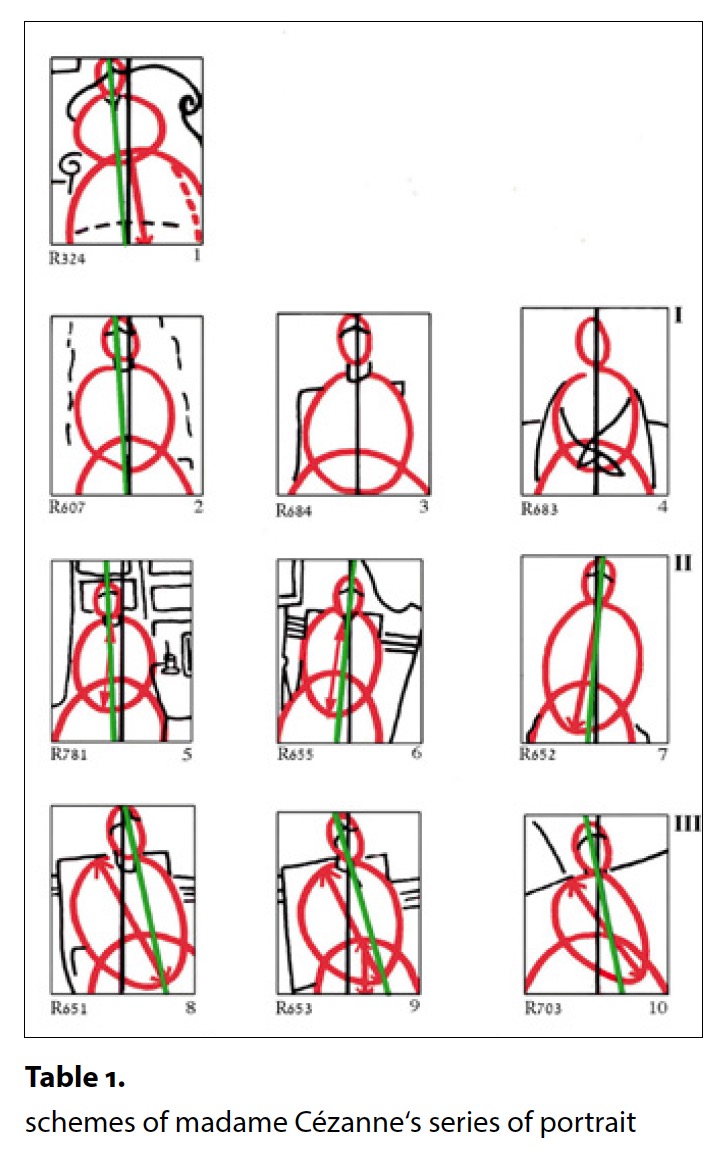 In all these paintings, the figure is situated at the center of the painting. In the first two sets, she is seated in a frontal position while in the third set (as shown in Table I), the upper half of the body and the arms are turned to the right. While in the first set of paintings (as shown in Table 1-I) the figure’s main axis and the axes of the ellipses and the vertical axis of the format are almost completely congruent (as shown in black in table 1), in the second group (II), the figure’s axis (shown in green) diverge slightly from the central axis of the format (shown in black), and the axes of the ellipses (in red) diverge from that of the figure, who is still seated in a frontal pose, but slightly inclined to the right or to the left.
In all these paintings, the figure is situated at the center of the painting. In the first two sets, she is seated in a frontal position while in the third set (as shown in Table I), the upper half of the body and the arms are turned to the right. While in the first set of paintings (as shown in Table 1-I) the figure’s main axis and the axes of the ellipses and the vertical axis of the format are almost completely congruent (as shown in black in table 1), in the second group (II), the figure’s axis (shown in green) diverge slightly from the central axis of the format (shown in black), and the axes of the ellipses (in red) diverge from that of the figure, who is still seated in a frontal pose, but slightly inclined to the right or to the left.
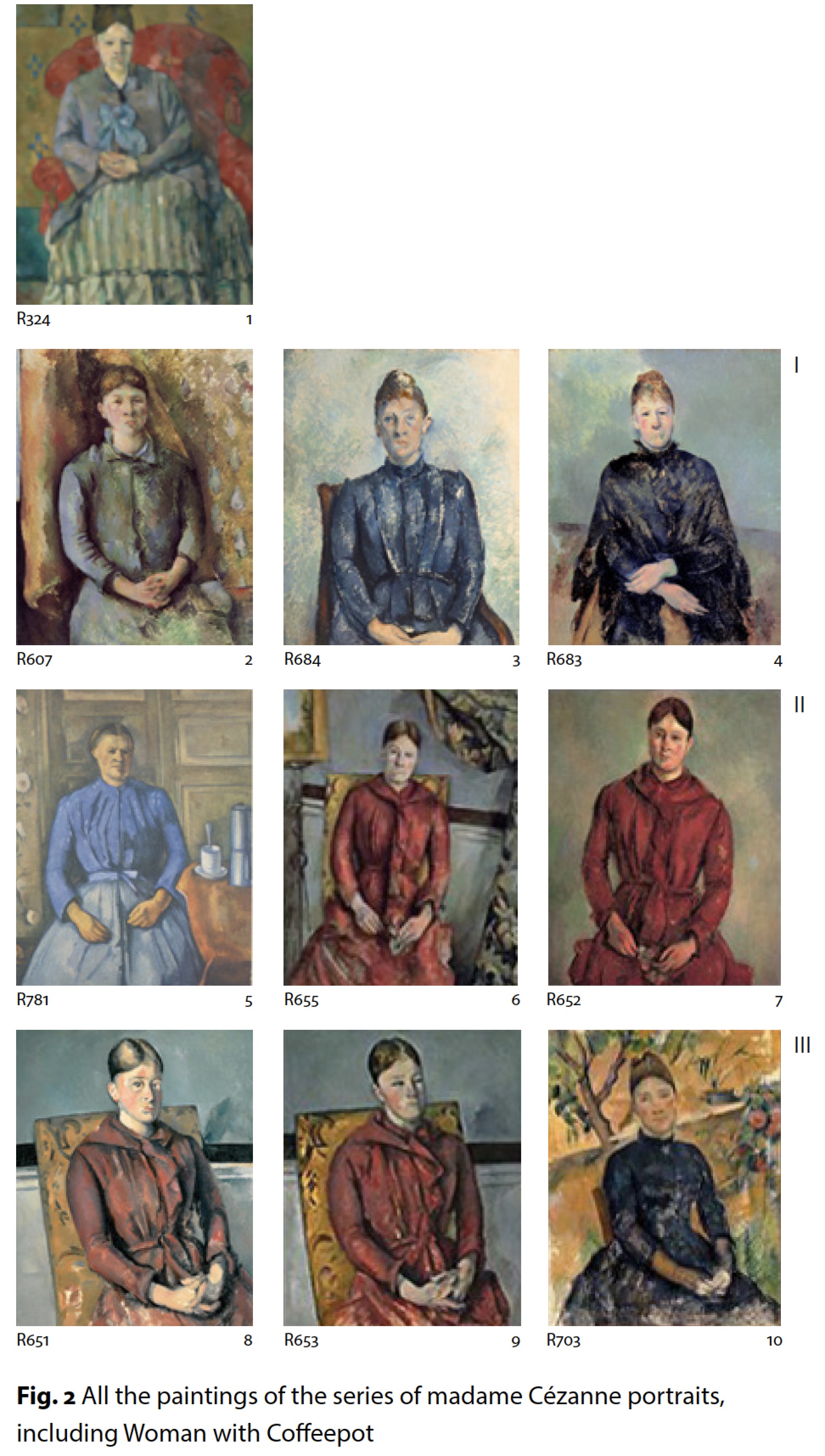 I have opted to include in this group the painting Woman with a Coffeepot (1888–90, Musée d’Orsay, Paris Fig. 2 II/5 and Table 1 II/5), the only one in the series that is not a portrait of the artist’s wife. The axis of the woman’s body in this painting is slightly inclined to the left—but the fact that it coincides with the axes of all the ellipses (with the exception of that of the head, which is slightly inclined), and the geometrical design in the background, give the painting a comparative static character (Fig. 3 c&d). That said, the inclined orientation of the doorframes behind the figure (shown in green) and of the flowery wallpaper in the left-side background, do give the composition a certain vitality and tension, that alleviate the initial impression of stiffness elicited by this painting in comperison to the other portraits.
I have opted to include in this group the painting Woman with a Coffeepot (1888–90, Musée d’Orsay, Paris Fig. 2 II/5 and Table 1 II/5), the only one in the series that is not a portrait of the artist’s wife. The axis of the woman’s body in this painting is slightly inclined to the left—but the fact that it coincides with the axes of all the ellipses (with the exception of that of the head, which is slightly inclined), and the geometrical design in the background, give the painting a comparative static character (Fig. 3 c&d). That said, the inclined orientation of the doorframes behind the figure (shown in green) and of the flowery wallpaper in the left-side background, do give the composition a certain vitality and tension, that alleviate the initial impression of stiffness elicited by this painting in comperison to the other portraits.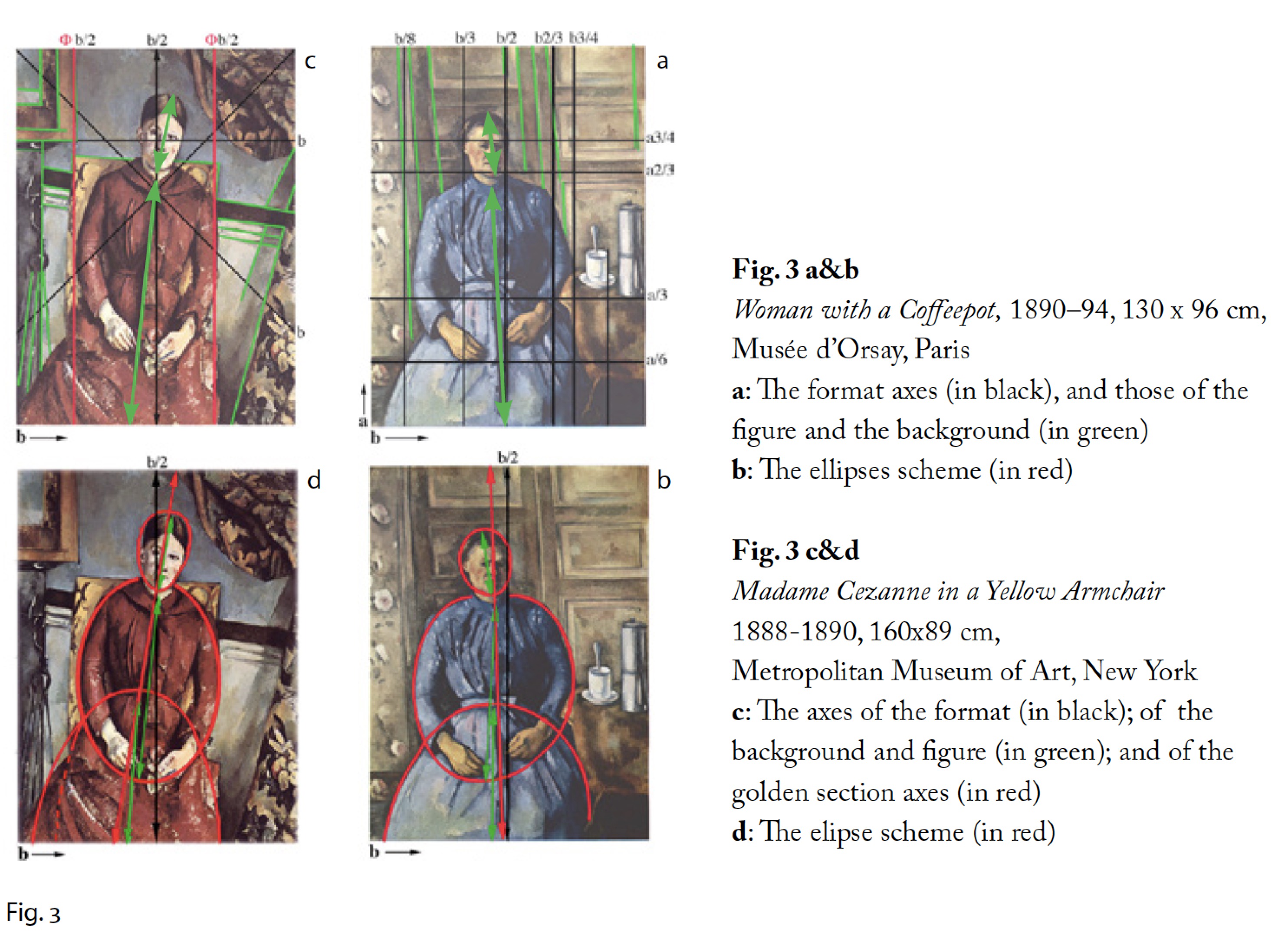 In the painting Madame Cézanne in the Yellow Armchair (1888–90, Metropolitan Museum, New York Fig. 3 a&b), the artist’s wife is shown in virtually the same pose as that of the Woman with the Coffeepot—except that here she is inclined toward the right side of the frame. This inclination, coupled with the rich color, ornate background, baroque-like drapes and dramatic diagonals of the fireplace behind the armchair (both vertically and horizontally), enhance the sense of tension inherent in the compositional structure: only the back of the armchair and the corner of a picture frame on the upper left side of the composition appear to hold back the persistent drift of one’s gaze to the right.
In the painting Madame Cézanne in the Yellow Armchair (1888–90, Metropolitan Museum, New York Fig. 3 a&b), the artist’s wife is shown in virtually the same pose as that of the Woman with the Coffeepot—except that here she is inclined toward the right side of the frame. This inclination, coupled with the rich color, ornate background, baroque-like drapes and dramatic diagonals of the fireplace behind the armchair (both vertically and horizontally), enhance the sense of tension inherent in the compositional structure: only the back of the armchair and the corner of a picture frame on the upper left side of the composition appear to hold back the persistent drift of one’s gaze to the right.
In the third set of paintings (Fig. 2- III and Table 1-III), the body’s pose is no longer full frontal, and the divergence of the painting axis (in black) from that of the body is accentuated and —moreover, the axes of the three constituent ellipses of the body in red do not coincide. Here we see a process that reaches its peak in the painting Madame Cézanne in the Greenhouse (1891–92, Metropolitan Museum, New York—Fig. 2-10 and Table 1–10), in which the tension between the three ellipses is wonderfully balanced. The first of these ellipses—, the head, which is seen full frontal but slightly inclined—is tangential to the second, diagonally-oriented and egg-shaped ellipse that encompasses the arms and upper body, which are turned to the right side of the painting. The third, cropped ellipse—as defined by the dress—gives the figure its stability. The contrast between the diagonal lines of the fence railing and the tree trunk that springs perpendicular to it, with the flowery vegetation in the background, offers a kind of refined echo of the formal tensions within the figure itself (Fig.4 a&b).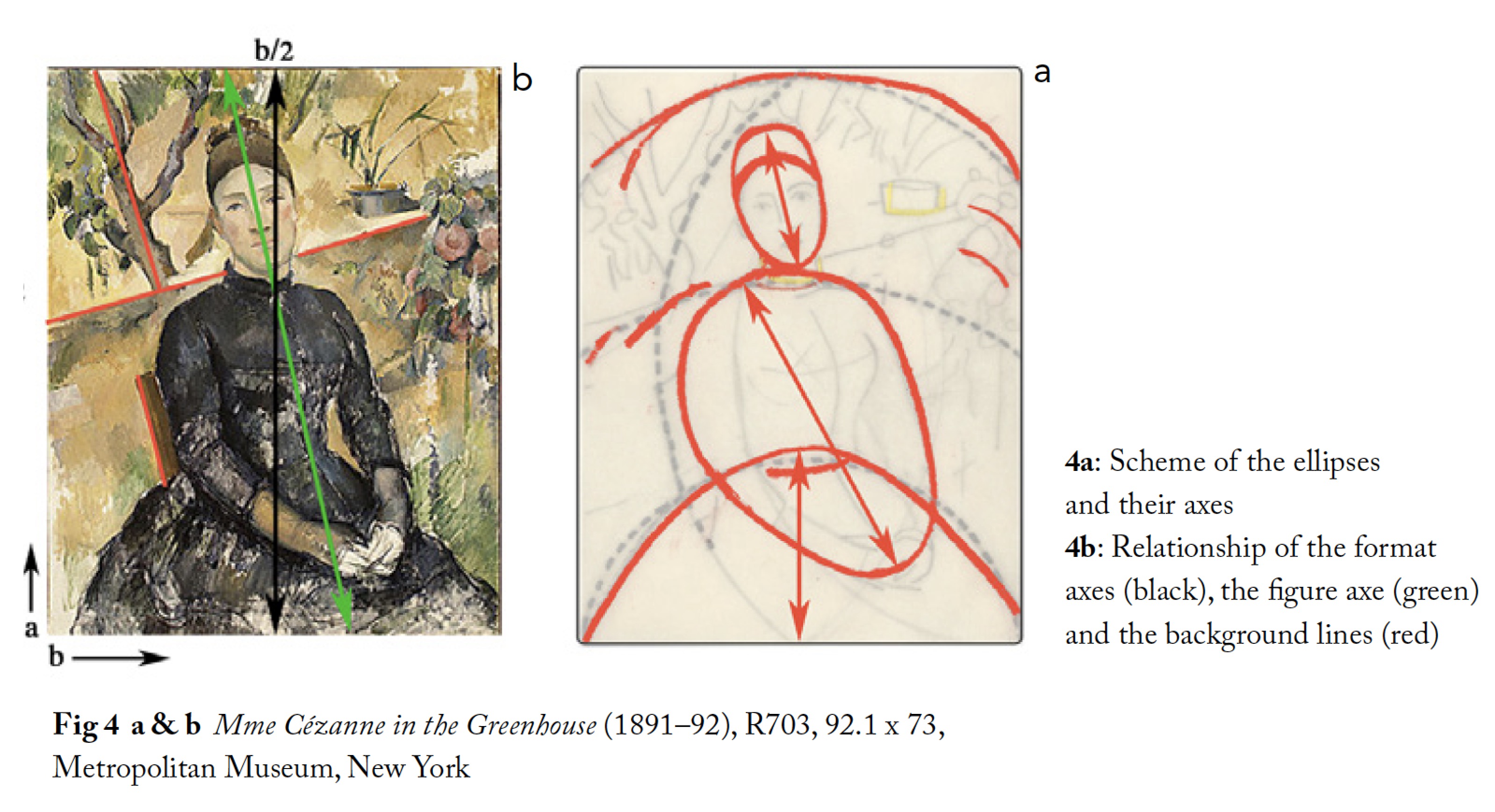 In general, there is a clear tension in the composition between the schematic arrangement of the figure and the transparent and delightful colorfulness of the painting overall—a tension that is somewhat attenuated by the free brushwork and glimpses of the bare canvas—especially at the bottom of the painting.
In general, there is a clear tension in the composition between the schematic arrangement of the figure and the transparent and delightful colorfulness of the painting overall—a tension that is somewhat attenuated by the free brushwork and glimpses of the bare canvas—especially at the bottom of the painting.
In the two variations of Madame Cézanne in a Yellow Armchair (Art Institute, Chicago—Fig. 5) and a private collection variant (no.8 in table 1 and in Fig 2), both of which apparently preceded the greenhouse portrait—the body and the head are similarly inclined, and the background is calmer—notwithstanding the black stripe in the background that appears at a different height on either side of the armchair. Only the fingers of the clasped hands, the folds of the dress and of the collar, and the curled leaves on the armchair embroidery, communicate a certain feeling of restlessness.
Throughout the series, the subject was always a woman painted in an intimate ambience (Figure 5 a&b). 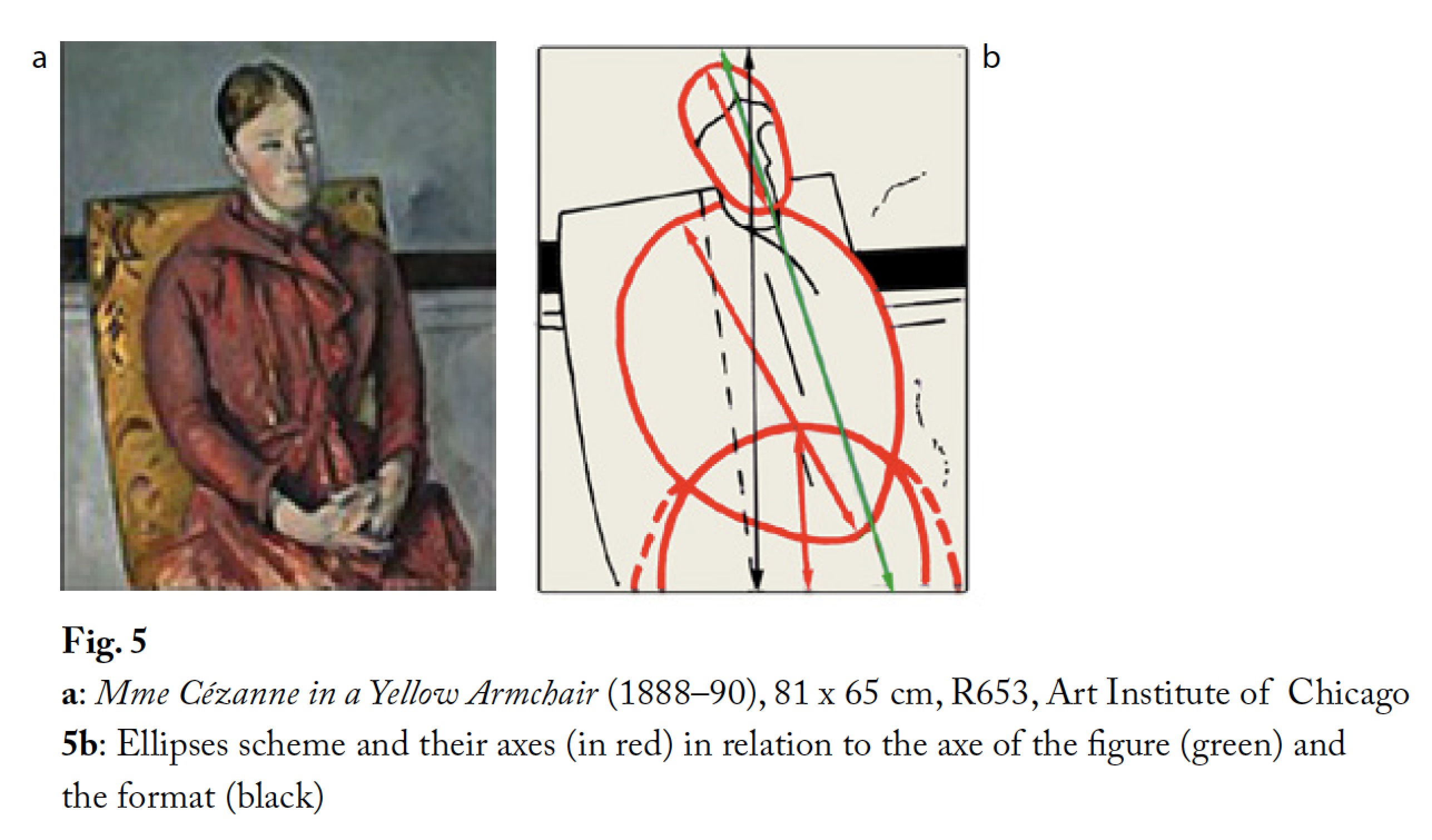 It is quite likely that the four paintings in which the artist’s wife appears in a red dress were painted consecutively, and at the same house (quai d’Anjou 15, Paris). However, the series also reflects the changes in the artist’s style during that period with regard to the use of color, brushwork, and rhythm.
It is quite likely that the four paintings in which the artist’s wife appears in a red dress were painted consecutively, and at the same house (quai d’Anjou 15, Paris). However, the series also reflects the changes in the artist’s style during that period with regard to the use of color, brushwork, and rhythm.
The paintings’ formal theme develops in line with its own distinctive rhythm, as Cézanne explores various means of creating tensions and balancing them within the relationship and associations between the formal components of the figure, between her and the background, and the principal axes of the painting’s format. This is evident if one compares the first iteration of Madame Cézanne in the Red Armchair (the prototype of the series) and the final one (the perfect resolution of his quest), in Madame Cézanne in the Greenhouse (Table 2 a&b).
* * *
Of all the portraits of Madame Cézanne, it is actually the initial prototype of the series that ultimately attracted the most attention in the twentieth century. One such artist—out of many—is Juan Gris (1887–1927), who produced numerous drawings in 1916 based on Cézanne’s paintings, one of the most accomplished of which was inspired by Madame Cézanne in the Red Armchair of 1877. Although he faithfully copied the figure, Gris presented the forms (especially of the face, the cloak, and the chair) in a stylized geometric fashion (Fig. 6). He was clearly struck by the portraits’ powerful presence, and tried to render the Cézannesque volumes into the new Cubist idiom. A similar, more sophisticated, attempt of his is evident in two other drawings that he created in response to Madame Cézanne in a Yellow Armchair (1890–94, Art Institute, Chicago): one featuring only the woman’s head and shoulders, and the other encompassing the folded hands, as well. However, Gris does not appear to have noted the overall schemetic composition that appears repeatedly in the series.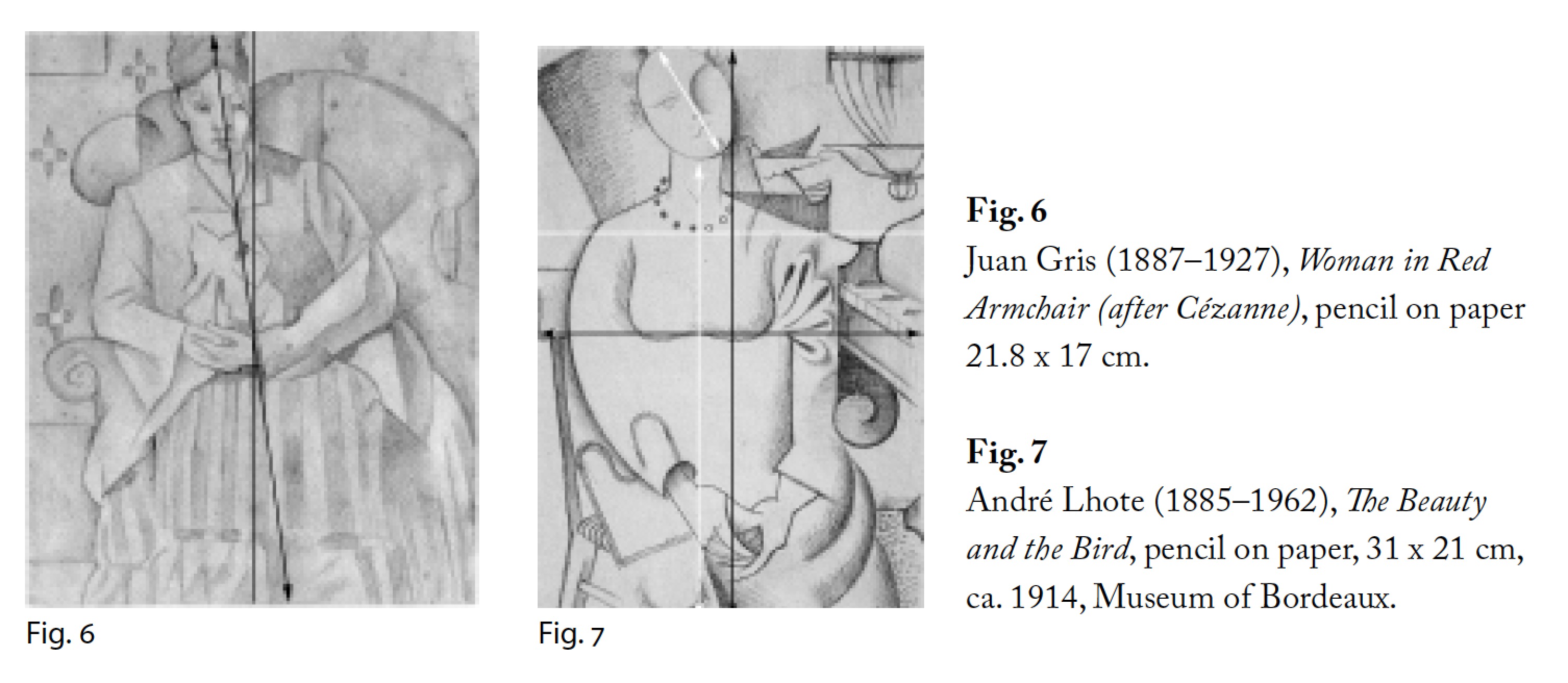 In 1914, André Lhote (1885—1962)—another Cubist admirer of Cézanne—produced a drawing of a seated woman, titled The Beauty and the Bird (Fig. 7), which has several clear hints of the same portraits of Mme Cézanne that Gris had copied: a clear scroll-like form next to her left elbow reminiscent of the armchair rest in the 1877 painting; the hands -—a virtual replica of her hands in Portrait in a Yellow Armchair (R. 653, R.651); the stylized head in the form of a precise ellipse, inclined sideways as in the painting Mme Cézanne in the Greenhouse, the armrest and the rectangular shape behind her head suggestive of the fence and angled tree in that painting[xvi]. The body’s pose, on the other hand, is entirely frontal. Lhote, who was also a theoretician and art critic, was presumably consciously borrowing elements from several of Cézanne’s paintings.
In 1914, André Lhote (1885—1962)—another Cubist admirer of Cézanne—produced a drawing of a seated woman, titled The Beauty and the Bird (Fig. 7), which has several clear hints of the same portraits of Mme Cézanne that Gris had copied: a clear scroll-like form next to her left elbow reminiscent of the armchair rest in the 1877 painting; the hands -—a virtual replica of her hands in Portrait in a Yellow Armchair (R. 653, R.651); the stylized head in the form of a precise ellipse, inclined sideways as in the painting Mme Cézanne in the Greenhouse, the armrest and the rectangular shape behind her head suggestive of the fence and angled tree in that painting[xvi]. The body’s pose, on the other hand, is entirely frontal. Lhote, who was also a theoretician and art critic, was presumably consciously borrowing elements from several of Cézanne’s paintings.
Unlike Gris and Lhote, Amadeo Modigliani (1884–1920) adopted the same underlying scheme as Cézanne, and since 1915 applied it in his own fashion to dozens of portraits of women and… of men. One example out of many is the painting Boy in Striped Sweater (Fig. 8, 1918) which—like many of these portraits—bears a striking Cézannesque influence, both in the range of color and in the brushwork of the background. The head and the hands, on the other hand, are painted in bold colors (usually a reddishbrown), and their features are highly stylized.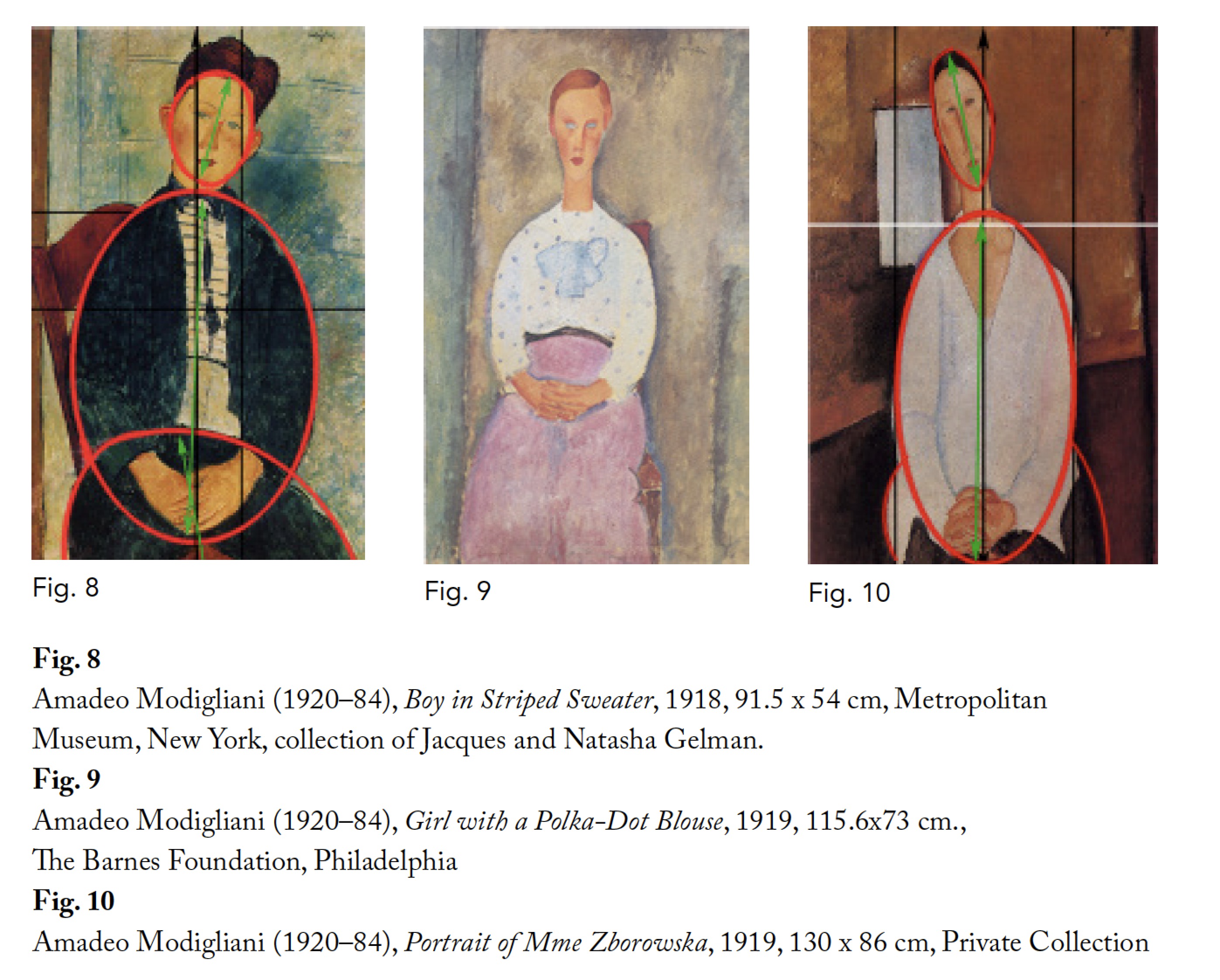 In his painting Jeune Fille au Corsage à Pois (Fig. 9—1919), the Cézannesque scheme is very apparent. Moreover, in contrast to the light pastel colors of the figure, the Cézanne-like treatment of the background is very prominent—both in terms of the hues and in terms of the brushstrokes[xvii].
In his painting Jeune Fille au Corsage à Pois (Fig. 9—1919), the Cézannesque scheme is very apparent. Moreover, in contrast to the light pastel colors of the figure, the Cézanne-like treatment of the background is very prominent—both in terms of the hues and in terms of the brushstrokes[xvii].
As Modigliani’s own distinctive elongated colorful expression began to emerge, the ellipses became increasingly narrow and elongated—as, for example, in Portrait of Madame Zborowska of 1919 (Fig. 10). The inclination of the head toward the left is at once restrained yet accentuated by the white rectangle in the background; the severity of the central position of the figure is alleviated by the raising line of the floor behind her (a device often employed by Cézanne).
Ostensibly, the painting’s structure is classical and peaceful, but as in other Modigliani works, the expression lies predominautly in the deformation of the figure.
Picasso’s painting, Large Nude in a Red Armchair (1929, Fig. 11), is a deliberate and critical riff paraphrase on Mme Cézanne in a RedArmchair—as evident from the red armchair, the green background with its geometrical pattern (which in this case is of X- or cross-like elements), and the mirror in the yellow frame, akin to the similarly-positioned corner of a painting in Cézanne’s work.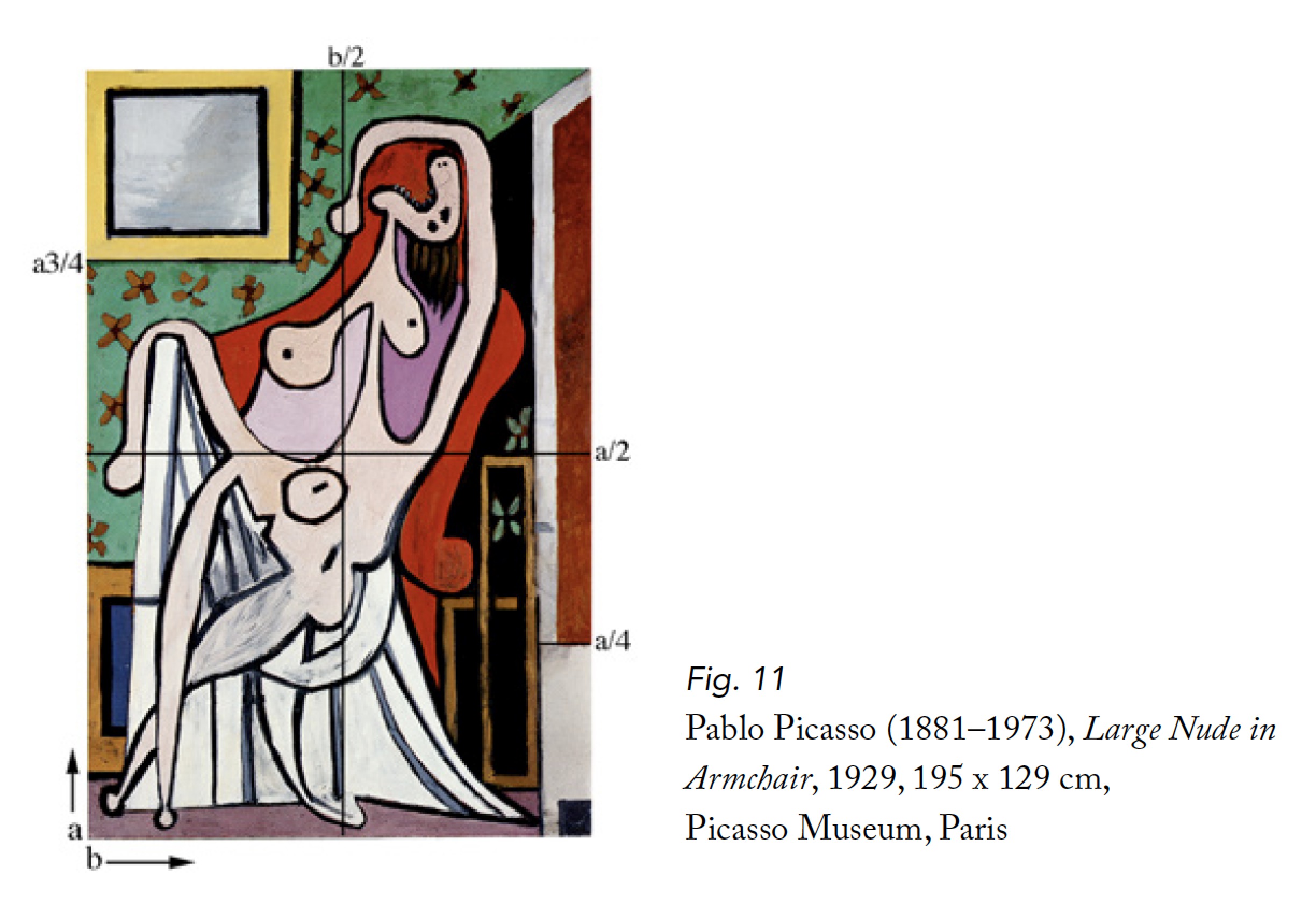 In the lower left of Picasso’s painting a long white rectangle is attached to a smaller diagonal one (presumably serving as the armrest of the chair that the woman’s right arm or leg is draped over). These blend in with a series of black lines against a white backdrop, echoing the stripes in Mme Cézanne’s dress. Although these are all casual, free-style references, they are readily identified with elements in Cézanne’s work. Picasso’s distorted nudity, the screaming mouth, bold colors, and black outlines (that Cézanne despised), however, are as well paraphrases of Matisse’s odalisques (which, in turn, are references to Cézanne’s Women Bathers). Thus, in this painting Picasso is referring both to Cézanne and to Matisse, with a wry dig not at Cézanne, but at his superficial imitators. It is clear, therefore, why Picasso was not focusing on the Cézannesque scheme that many others had adopted: While he himself created many series of his own, most of them concerned the development of a narrative rather than the invention of formal variations of conceptual or symbolic thematic motifs[xviii].
In the lower left of Picasso’s painting a long white rectangle is attached to a smaller diagonal one (presumably serving as the armrest of the chair that the woman’s right arm or leg is draped over). These blend in with a series of black lines against a white backdrop, echoing the stripes in Mme Cézanne’s dress. Although these are all casual, free-style references, they are readily identified with elements in Cézanne’s work. Picasso’s distorted nudity, the screaming mouth, bold colors, and black outlines (that Cézanne despised), however, are as well paraphrases of Matisse’s odalisques (which, in turn, are references to Cézanne’s Women Bathers). Thus, in this painting Picasso is referring both to Cézanne and to Matisse, with a wry dig not at Cézanne, but at his superficial imitators. It is clear, therefore, why Picasso was not focusing on the Cézannesque scheme that many others had adopted: While he himself created many series of his own, most of them concerned the development of a narrative rather than the invention of formal variations of conceptual or symbolic thematic motifs[xviii].
Conversely, Cézanne’s serial work can be considered as a dogged and consistent pursuit of ever more sophisticated and accurate formulas, in a bid to ‘prove’ the theory, or the basic idea, that gave rise to each of the series that he created. He clearly remained faithful to the notional and formal concept that gave rise to the underlying scheme, and as a consequence, the series as a whole[xix].
* * *
In Formalist art criticism of the mid-twentieth century, Cézanne was said to be the first to have liberated painting from ‘literary’ sources, and to tackle purely formal challenges, instead. In truth, however, Cézanne was very much interested in the meaning, that he wanted to convey in his paintings—but only after establishing it through the structure of the painting itself did he allow himself to pursue ever more complex and precise formal solutions. In hindsight, the serial approach that he adopted proved to be a very apt means toward this end, and that—and not only in his approach to form—is one of his most important innovative contributions to modern painting.
Finally, was the series the result of Cézanne‘s fervent wish to pursue and ultimately achieve a coveted perfection? It appears that an expectation of that sort is indeed what drove him repeatedly to revisit to certain formal motifs, in an effort to approach a degree of perfection, that is so difficult to achieve in a single work of art.
Notes
[i] This group comprises original motifs, including those painted from nature. These include, in Cézanne’s early years, his erotic themes, and in his later years, themes such as the The Card Players series. Also in this series are the 78 works of The Bathers (male or female), which represent approximately 16% of the paintings in this group.
[ii] Aphorism #VII of Cézanne’s sayings, as compiled by his son, and first published in Leo Larguier’s book, Le dimanche avec Paul Cézanne, souvenirs, Paris, 1927, and subsequently in the book P. M. Doran (éd.), Conversations avec Cézanne, 1978, p. 14.
[iii] Attributed to Cézanne in Joachim Gasquet, Paul Cézanne, Paris 1921, p. 80.
[iv] From a letter to Gasquet dated September 26, 1897, in John Rewald, Cézanne, Geffroy et Gasquet suivi des souvenirs sur Cézanne par Louis Aurenche et des lettres inédites, Paris 1959, p. 33.
[v] See Saying #XLI (Note 2).
[vi] See Maurice Merleau-Ponty, “Le doute de Cézanne” in Sens et Non-sens, Paris 1948, p. 23.
[vii] Between 1866 and 1869 (precise date unknown), Cézanne completed a social game questionnaire titled Mes confidences [My Secrets], which was first published in 1973 in Chappuis’s catalogue risonné. In response to question #10, Quelle est, selon vous, l’idéal du bonheur terrestre? [What, in your opinion, is the ideal earthly happiness?], he replied: “Avoir une belle formule.” [To have a good formula.] In response to Question #16: Quelle est votre principale espérence? [What is your main hope?] he wrote: “La certitude.” [Being certain.]. See Conversations avec Cézanne, P. M. Doran (ed.), Macula. Paris, 1978, p. 102–103 [in French].
[viii] Larguier, Le dimanche avec Paul Cézanne, p. 15, Text # XXI—parts of which are cited in 8. Saying XXI, ibid., in Larguier, Le dimanche avec Paul Cézanne, p. 15, parts of which are cited in Doran, Conversations avec Cézanne.
[ix] Ibid., Saying #XXXIX, p. 17.
Jacques Teboul, Les victoires de Cézanne, Adam Biro, Paris, 1988, p. 8, 11–12. Even though Cézanne was not the only artist to paint series at that time, contrary to Teboul’s assertions, he was the first to conceive of the idea of serial work when, in 1875, he created the founding formula for the parallel series of male and female bathers.
[xi] According to François Chédeville and Raymond Hurtu, Cézanne painted 31 oil paintings, two watercolors, and 84 drawings of his wife—a total of 117 works, and far more than any other individual that he portrayed. See their detailed book at http://www.societe-cezanne.fr. Cézanne’s relationship with Hortense Fiquet (1850–1922) began in 1869. In 1872 their son Paul was born. Cézanne initially hid all knowledge of their existence from his father, officially marrying Hortense only in 1886—some six months before his father’s death.
[xii] The figure of the sewing mother in the painting Girl at the Piano (Overture to Tannhauser) (ca. 1869, 57 x 92 cm, Hermitage Museum, St. Petersburg) might be considered to be a formal precedent of this painting.
[xiii] See Rainer Maria Rilke, Lettres sur Cezanne, Seuil, Paris,1991, p. 72 [in French]. Elsewhere I have discussed how Cézanne sought to achieve a balance in his works between opposing forces, and that one of the signs of his greatness was that he did not hide the existence of these tensions, but on the contrary, left them clearly revealed to the observer, such that the observer is made aware both of their existence and of the fact that they are in equilibrium.
[xiv] See Note 11 above. According to Chédeville and Hurtu, in these years the couple alternated between living together and living apart, while respecting each other’s freedom and enjoying a relationship of intimacy and a certain gentleness.
[xv] I have organized the sets based on the formal characteristics of the composition, rather than strictly chronologically. In any event, all the paintings—with the exception of The Painter’s Wife in a Red Armchair (which was the starting point of the series)—were painted betwen 1888 and 1891.
[xvi] As early as 1912, Lhote painted Portrait of Marguerite (oil on canvas, 159 x 85 cm), inspired by Cézanne. See his article “L’enseignment de Cézanne, La Nouvelle revue française, 1923, in André Lohte, Les invariants plastiques, Hermann, Paris, 1967, pp 39–58 [in French].
[xvii] The painting is with at the Barnes Collection in Marion, Philadelphia, and pictured in the catalogue next to a smaller reproduction of a portrait of Mme Cézanne (R652), dated by Chédeville and Hurtu to 1888–89. See the exhibition catalogue De Cézanne à Matisse: Chefsd’oevre de la fondation Barnes, musee d’Orsay, Paris 1993 e [in French].
[xviii] See exhibition catalogue of Picasso et les maîtres, Grand Palais, Paris, October 2008–February 2009 [in French].
[xix] See my book on Cézanne’s series of paintings of bathers, Cézanne: Baigneuses et Baigneurs, theme et composition, A. Biro, Paris 2002 [in French].

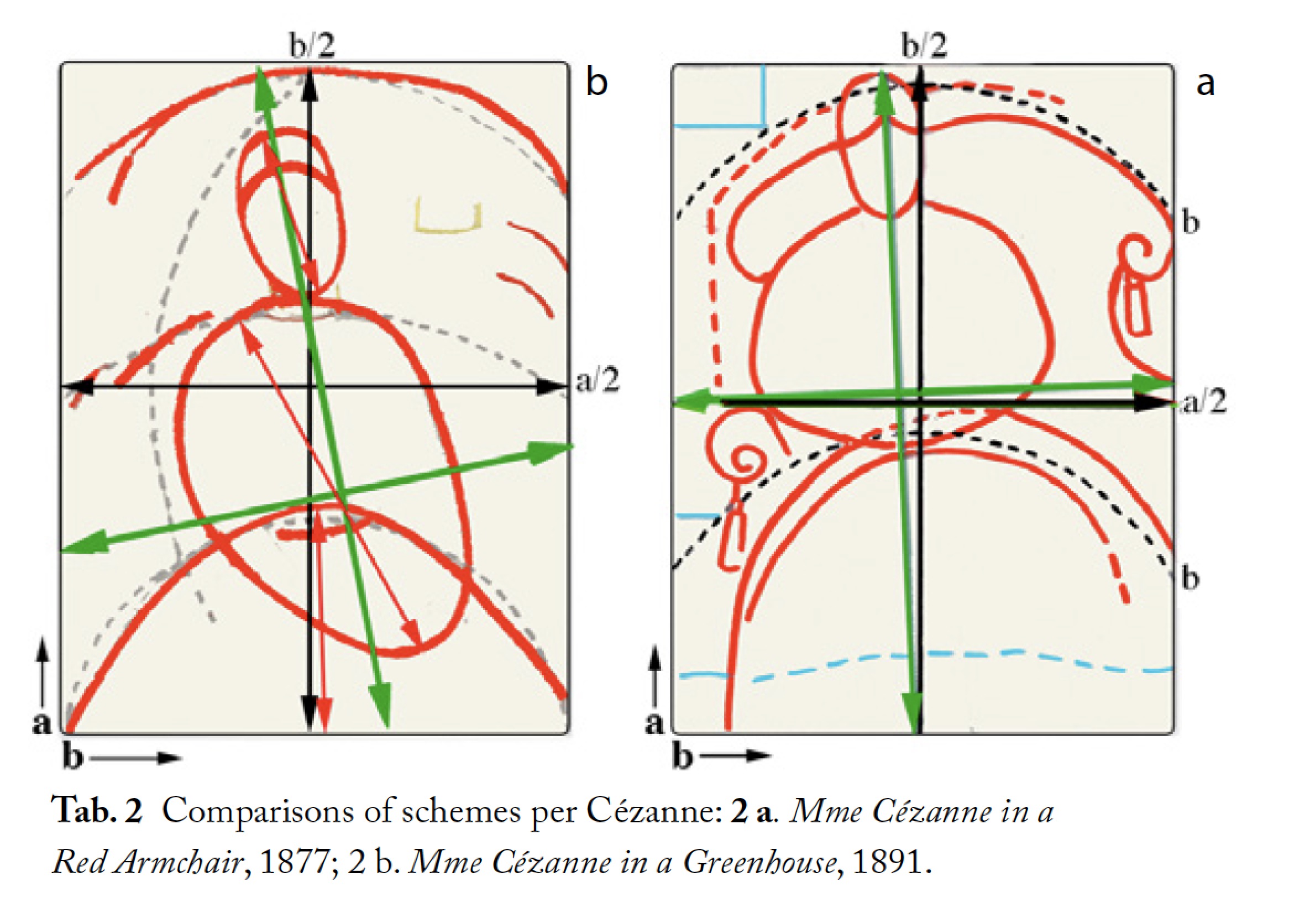

Vous devez être connecté pour poster un commentaire.